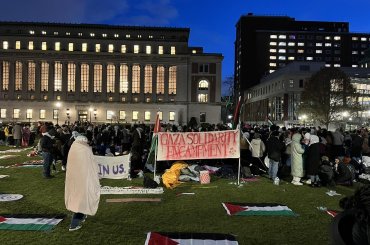Memory for Movement, a documentary presented as a powerful poetic memoir style reflection, written and produced by Mahdi Diab, takes the viewer into the mental and physical landscape of a native Jerusalem-Palestinian dancer, Sari Husseini. The documentary begins in a pitch of darkness, our focus solely on the words of the Palestinian prophet of humanism–poet Mahmoud Darwish. And from these words comes light, and a young man deep in thought, standing before Darwish’s majestic memorial. With Darwish’s powerful poetry in mind, Sari reflects on his day’s journey up to this point, which we see through visions of flashbacks: dehumanizing waits at Israeli military checkpoints, the smoke which continually rises from Palestinian villages and olive trees as settler condominiums are quickly built in their place, and long walks along side of the towering Apartheid wall which divides his heart as it divides the landscape of his childhood.
As a call to action, and as a testament to the power of individual and collective will, on Darwish’s memorial we see the words “the butterfly effect is not seen, the butterfly effect will not disappear”. Sari finds strength in these words, taking the seemingly hopeless circumstances of the Palestinian condition and finds an inspiring hope through the art of movement. He travels to the communities of Palestinian children to teach them to collectively channel their sadness and anger into creative movements which explore their cultural identity and aspirations. At the pinnacle of Sari’s journey we experience his own explorations with dance and see a personal dance rehearsal with Palestine’s El-Funoun Dance Troupe at their dance studio in Ramallah, Palestine.
El-Funoun Dance Troupe creates a space in which youth can express themselves freely and equally, imagine new realities and challenge existing social and cultural barriers. This serves to empower a new generation of Palestinians to use the arts to promote positive change within their community and breaks the cultural isolation that separates the isolated Palestinian territories from each other. The film advocates non-violent movement in response to Israeli structural violence and occupation, and a vision of one state in which all people are equal.
(The author is Mahdi Diab’s brother.)


Thank you for this sublime and humbling gift, Moe. It was soul- searing and haunting in its entirety.
Do you by any chance have the translation or even the name of the song that the troupe danced so movingly to?
(thanks also to your talented brother, Mahdi. This documentary should be shown at Film Festivals of all stripes. imho.)
i love this wonderful film. thank you do much Mahdi and Moe.
I cannot get the scenes from this film out of my head.
One of many things struck me– the young dancer wearing the I Love NY t-shirt. How she proudly wears the shirt of the enablers of her misery because she has hope and movement……….
To me, it confirms yet again that Palestinians have incredible fortitude, steadfastness, and hope. We need to acknowledge them as the amazing people that they are, and to fight for their justice instead of contributing so mightily to their misery and pain. We need to get real and to get honest. It’s past time for our government to embrace BDS in a big way. No more blank checks, no more vetoes, no more ‘greatest ally’ in the world.